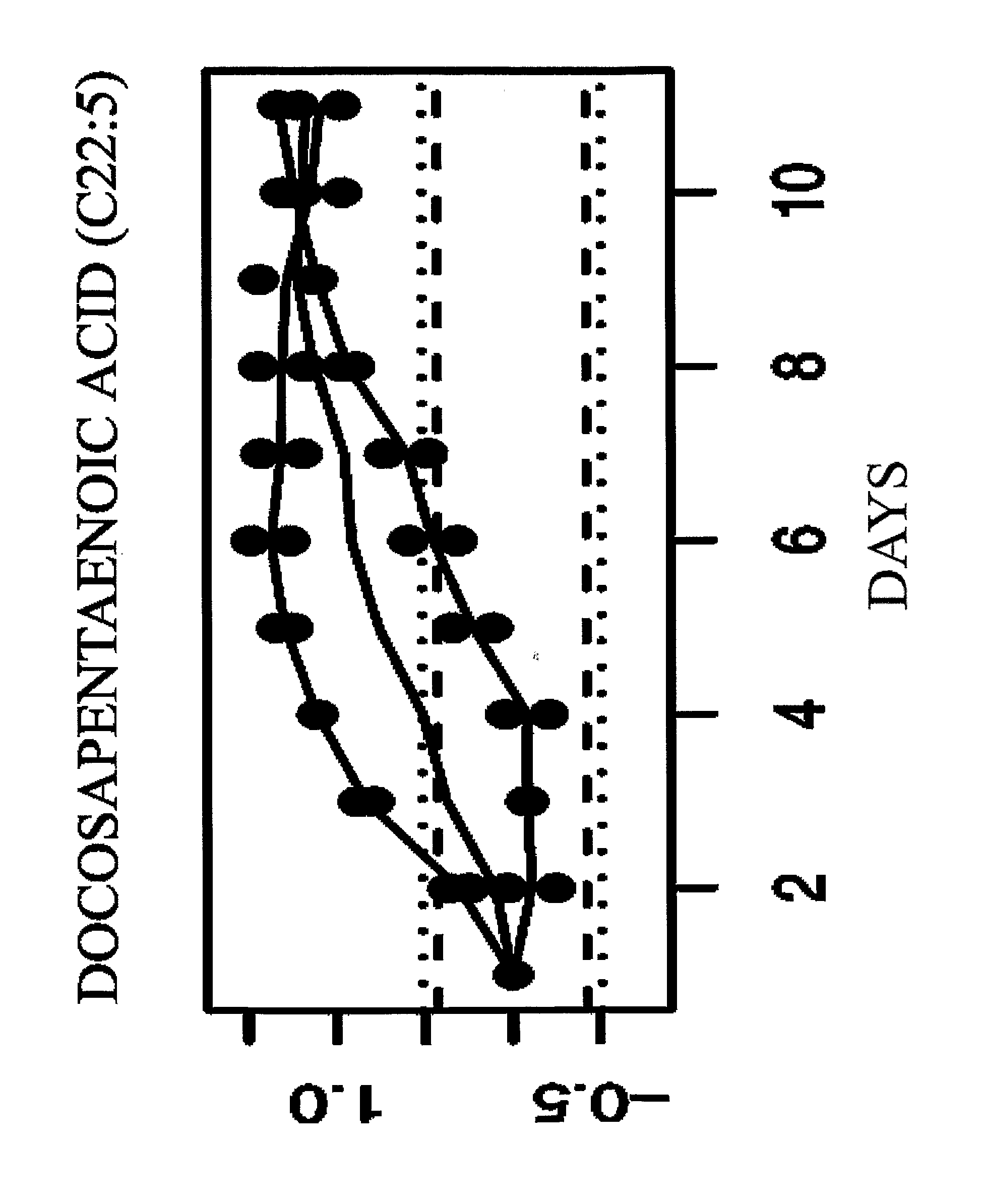Compositions containing high omega-3 and low saturated fatty acid levels
a technology of saturated fatty acid and composition, applied in the field of compositions, can solve the problems of fish oil unusable for human consumption, fishy odor and taste, unsatisfactory use in edible compositions, etc., and achieve the effect of increasing the level of epa
- Summary
- Abstract
- Description
- Claims
- Application Information
AI Technical Summary
Benefits of technology
Problems solved by technology
Method used
Image
Examples
example 2
EPA Composition
[0156]This Example describes the making of a composition produced by a heterotrophic or primarily heterotrophic batch culture of a microorganism to produce a microbial biomass process containing substantially only EPA in its n-3 HUFA fraction and relatively low levels of C14:0 and C16:0. The microorganism used is N laevis.
[0157]A modified Lewin's Diatom Medium (mLDM) was prepared from locally available ingredients according to the recipe of the UTEX website presently www.bio.utexas.edu / research / utex). 15 mg / L of sodium metasilicate 9H2O was added to the medium together with sufficient sodium nitrate to achieve a total concentration of sodium nitrate of 600 mg per liter. The mLDM is adjusted to pH 8.5 by titration of a dilute base. solution such as titration of 0.1 molar strength potassium hydroxide, autoclaved at 121 deg Celsius for 15 minutes and then rapidly cooled to prevent formation of precipitates.
[0158]Concentrated solutions of either D(−)fructose, glucose, la...
example 3
EPAOIL Production
[0171]This Example provides various products comprising compositions rich in EPA which can be produced in sufficient volumes such that they are suitable for human or animal ingestion in the first instance. Production is most feasible by means of cultivation of a micro-alga. If the set of genes providing for synthesis of EPA were to be taken from an organism possessing same, and transferred into another organism, such as a plant or animal, along with gene control mechanisms providing for expression of said genes at a reasonable level, then it might no longer be necessary to rely on micro-algae as the original source of EPA.
[0172]This Example includes human-acceptable food ingredients (such as spreads, powders, flavouring, vegetable fat-like materials, or oils not of pharmaceutical purity—20-50% EPA), functional foods (such as prepared chocolate bars, energy bars, dehydrated foods, or the like), beverages, dietary supplements, by which we mean products that are sold o...
example 4
Production of EPA Foods
[0198]This Example describes the production of EPA foods by feeding supplements containing substantially only EPA as their n-3 HUFA component and relatively low or nondetectable levels of C14:0 and C16:0 to non-aquaculture food producing animals. The administration of compositions containing substantially only EPA as their n-3 HUFA component and relatively low or non-detectable levels of C14:0 and C16:0 to non-aquaculture food-producing animals and the resulting production of novel food products with desirable modified fatty acid profiles is described.
[0199]Another way to pre-process compositions for preparation of human food is to pass the biomass through an existing type of food-producing animal, essentially adding a link to the food chain. The food products derived should be just as acceptable as traditional foods and food products from the food-producing animal, with the benefit that the fatty acid profile is advantageous to the health of the human. Althou...
PUM
| Property | Measurement | Unit |
|---|---|---|
| concentration | aaaaa | aaaaa |
| concentrations | aaaaa | aaaaa |
| concentrations | aaaaa | aaaaa |
Abstract
Description
Claims
Application Information
 Login to View More
Login to View More - R&D
- Intellectual Property
- Life Sciences
- Materials
- Tech Scout
- Unparalleled Data Quality
- Higher Quality Content
- 60% Fewer Hallucinations
Browse by: Latest US Patents, China's latest patents, Technical Efficacy Thesaurus, Application Domain, Technology Topic, Popular Technical Reports.
© 2025 PatSnap. All rights reserved.Legal|Privacy policy|Modern Slavery Act Transparency Statement|Sitemap|About US| Contact US: help@patsnap.com



